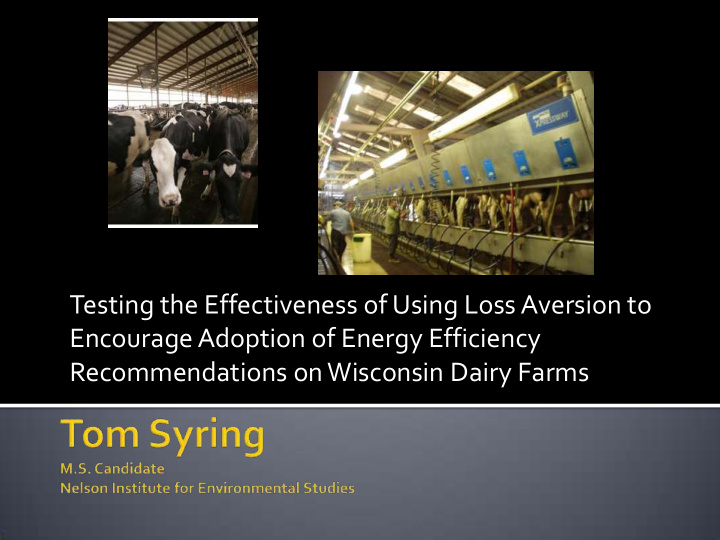



Testing the Effectiveness of Using Loss Aversion to Encourage Adoption of Energy Efficiency Recommendations on Wisconsin Dairy Farms
“The central characteristic of agents is not that they reason poorly but that they often act intuitively. And the behavior of these agents is not guided by what they are able to compute, but by what they happen to see at a given moment.” Daniel Kahneman
The apparent gap between the optimal level of energy efficient technology, and the actual amount adopted in the marketplace (Jaffe & Stavins, 1994) 20-24% for electricity (Nadel, Shipley & Elliot, 2004) Potential to save $48 Billion annually on electricity (0.35% of U.S. Economy)
Utility programs to promote energy efficiency and load-shifting Spending ($2008) $4B in 1993 $1.5B in 2003 $3.7B in 2008 (EIA,2008) Focus on Energy -Wisconsin
Slow diffusion of technology Market barriers (Brown, 2001) Principle-agent problems Bounded rationality Low priority on energy efficiency Incomplete markets for energy efficiency Market failures (DeCanio, 2004) Monopolies Externalities Public goods
Behavioral Failures (Shogren and Taylor, 2008) Bounded rationality (Simon, 1955) Anchoring and adjustment (Kahneman & Tversky, 1974) Certainty and pseudo-certainty effects (Kahneman & Tversky, 1979, 1981) Endowment effect (Thaler, 1980) Status quo bias (Samuelson & Zeckhauser, 1988) Accessibility bias (Kahneman, 2003) Expectations bias (Ariely, 2008) Framing effects (Hammon, Keeney & Raiffa, 2006) Loss aversion (Kahneman & Tversky, 1979)
Carriers of value are changes in wealth or welfare, rather than final states S-shaped value function: Reference dependent Defined on gains and losses Steeper for losses than gains Shows loss aversion
“The aggravation that one experiences in losing a sum of money appears to be greater than the pleasure associated with gaining the same amount,” (Kahneman & Tversky, 1979, p279). Found in many lab studies, and used to explain the equity premium puzzle, (Benartzi & Thaler, 1995), seller behavior in real estate markets, (Genosove & Mayer, 2001), the high volatility of individual stock prices, (Barberis & Huang, 2001), and risk taking in international politics, (Jervis, 1992).
Can loss aversion be used to encourage adoption of energy efficiency recommendations?
Send one of two versions of a letter to dairy farmers that had received energy audits through Focus on Energy in 2009. Recipients randomized into two treatment groups and a control group. All letters will encourage the farmers to contact Focus for help implementing the best remaining energy efficiency improvement from the earlier audit.
Hypothesis: subjects receiving a message of financial loss due to energy costs will respond at a higher rate than subjects receiving a message of financial savings in energy costs resulting from the installation of new equipment. Null hypothesis: there will be no significant difference in the response rates of the two treatment groups.
531 farms were split into 3 groups: two treatments and one control 357 letters were sent out, each one customized to the particular recipient 179 “Losing” letters 178 “Save” letters 174 Controls
Letters were mailed July 1, 2010. Responses were received until July 31, 2010. Beginning in August, three telephone attempts were made to reach each non-respondent, prompting them for a response to the letter. The caller was blind to which treatment letter had been sent to each subject.
Combined Losing Save Letters Letters Letters/phone Controls letter Letter Positive Positive response 43 1 Response 5 2 No positive No positive response 113 173 response 174 176 Losing 2.7%, Save 1.1% p=.4485 Letters & Phone 27.6%, Controls 0.6%, p<.0001 Letter & Losing Save Phone Call letter Letter Positive response 15 28 No positive All results were placed into 2 x 2 contingency response 58 55 tables and analyzed for significant differences In response rates using Fishers exact test. Losing 20.5%, Save 33.7%, p=.0745
The results of the letter campaign were inconclusive, due to the low response rate (N). The results of the combined letter and telephone treatment trended toward the Save letter being more effective than the Losing letter, although the results only approached significance, p=.0745. The combined letter and telephone treatment showed significant effects over no treatment (controls), p<.0001.
There was no evidence to support that a message of loss led to increased interest in adopting the recommended efficiency improvement. Contrary to expectations, the save message may have been more effective than the losing message.
Low N Homogeneous group may respond differently than other groups Subjects may have interpreted save as “not losing” Specific language in the “Losing” letter may have created an affective (emotional) response in subjects
Within same population, attempting to get higher number of responses. Test specific language with focus groups and refine it before going to larger field trials.
Loss aversion is a robust finding. Despite the results of the current study, fine tuning the message may enable programmers to increase adoption of energy efficiency measures. Questions? Questions? Questions?
Recommend
More recommend